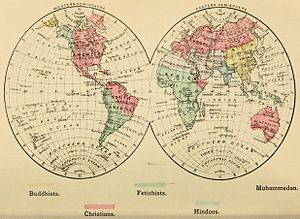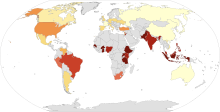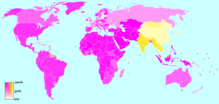The world's principal religions and spiritual traditions may be classified into a small number of major groups, though this is not a uniform practice. This theory began in the 18th century with the goal of recognizing the relative levels of civility in different societies,[2] but this practice has since fallen into disrepute in many contemporary cultures.
Worldwide percentage of adherents by religion as of 2020[1]
Religious demographics

One way to define a major religion is by the number of current adherents. The population numbers by religion are computed by a combination of census reports and population surveys (in countries where religion data is not collected in census, for example the United States or France), but results can vary widely depending on the way questions are phrased, the definitions of religion used and the bias of the agencies or organizations conducting the survey. Informal or unorganized religions are especially difficult to count.
There is no consensus among researchers as to the best methodology for determining the religiosity profile of the world's population. A number of fundamental aspects are unresolved:
- Whether to count "historically predominant religious culture[s]"[3]
- Whether to count only those who actively "practice" a particular religion[4]
- Whether to count based on a concept of "adherence"[5]
- Whether to count only those who expressly self-identify with a particular denomination[6]
- Whether to count only adults, or to include children as well.
- Whether to rely only on official government-provided statistics[7]
- Whether to use multiple sources and ranges or single "best source(s)"
Largest religious groups
| Religion | Followers (billions) | Cultural tradition | Founded | References |
|---|---|---|---|---|
| Christianity | 2.4 | Abrahamic religions | Judaea (Middle East) | [8][9] |
| Islam | 1.9 | Abrahamic religions | Arabia (Middle East) | [10][11] |
| Hinduism | 1.2 | Indian religions | Indian subcontinent | [8] |
| Buddhism | 0.5 | Indian religions | Indian subcontinent | [9] |
| Folk religion | 0.4 | Regional | Worldwide | [12] |
Medium-sized religions
| Religion | Followers (millions) | Cultural tradition | Founded | References |
|---|---|---|---|---|
| Shinto | 100 | Japanese religions | Japan, 19th century | [13][14] |
| Taoism | 12–173 | Chinese religions | China, 2nd century CE | [15] |
| Voodoo | 60 | African religions | Dahomey, unknown origin date | [16] |
| Sikhism | 25–30 | Indian religions | Indian subcontinent, 15th century | [17] |
| Judaism | 14.7 | Abrahamic religions | Judah (Middle East), 6th to 5th century BCE | [8][18] |
| Spiritism | 5–15 | New religious movements | France, 19th century | [19] |
| Mu-ism | 5–15 | Korean religions | Korea, unknown origin date | [20][page needed] |
| Confucianism | 6–7 | Chinese religions | China, 6th to 5th century BCE | [21] |
| Baháʼí Faith | 5–7.3 | Abrahamic religions | Persia, 19th century | [22][23][nb 1] |
| Jainism | 4–5 | Indian religions | Indian subcontinent, 7th to 9th century BCE | [24][25] |
| Cheondoism | 3–4 | Korean religions | Korea, 19th century | [26] |
| Hoahaoism | 1.5–3 | Vietnamese religions | Vietnam, 20th century | [27] |
| Caodaism | 1.1–3 | Vietnamese religions | Vietnam, 20th century | [28] |
| Tenriism | 1.2 | Japanese religions | Japan, 19th century | [29] |
| Druze | 1 | Abrahamic religions | Egypt, 9th century | [30] |
By region
- Religions by country according to The World Factbook – CIA[31]
- Religion by region
- Religion in Africa
- Religion in Antarctica
- Religion in Asia
- Religion in the Middle East
- Muslim world (SW Asia and N Africa)
- Religion in Europe
- Religion in North America
- Religion in Oceania
- Religion in South America
Trends in adherence
| 1970–1985 (%)[33] | 1990–2000 (%)[34][35] | 2000–2005 (%)[36] | 1970–2010 (%)[23] | |
|---|---|---|---|---|
| Baháʼí Faith | 3.65 | 2.28 | 1.70 | 4.26 |
| Buddhism | 1.67 | 1.09 | 2.76 | |
| Christianity | 1.64 | 1.36 | 1.32 | 2.10 |
| Confucianism | 0.83 | |||
| Hinduism | 2.34 | 1.69 | 1.57 | 2.62 |
| Islam | 2.74 | 2.13 | 1.84 | 4.23 |
| Jainism | 2.60 | |||
| Judaism | 1.09 | -0.03 | ||
| Sikhism | 1.87 | 1.62 | 3.08 | |
| Shinto | -0.83 | |||
| Taoism | 9.85 | |||
| Zoroastrianism | 2.5 | |||
| unaffiliated | 0.37 |
Maps of self-reported adherence
- Map showing self-reported religiosity by country. Based on a 2015 worldwide survey by Pew.
- World map showing the percentages of people who regard religion as "non-important" according to a 2002 Pew survey
- Religions of the world, mapped by distribution
- Map showing the prevalence of "Abrahamic religion" (purple), and "Indian religion" (yellow) religions in each country
- Map showing the relative proportion of Christianity (red) and Islam (green) in each country as of 2006
Classification
Religious traditions fall into super-groups in comparative religion, arranged by historical origin and mutual influence. Abrahamic religions originate in the Middle East,[37][38] Indian religions in the Indian subcontinent (South Asia)[39] and East Asian religions in East Asia.[40] Another group with supra-regional influence are Afro-American religion,[41] which have their origins in Central and West Africa.
- Middle Eastern religions:[42]
- Abrahamic religions are the largest group, and these consist mainly of Judaism, Christianity, Islam, and the Baháʼí Faith. They are named for the Hebrew patriarch Abraham, and are unified by the practice of monotheism. Today, at least 3.8 billion people are followers of Abrahamic religions[43] and are spread widely around the world apart from the regions around East and Southeast Asia. Several Abrahamic organizations are vigorous proselytizers.[44] Abrahamic religions with fewer adherents include the Baháʼí Faith,[45] the Druze faith,[45] Samaritanism,[45] and Rastafari.[45]
- Iranian religions, partly of Indo-European origins,[46][47] include Zoroastrianism, Yazdânism, Uatsdin, Yarsanism, Manichaeism, and Yazidism.[48]
- Gnosticism, including historical traditions of Mandaeism, which is still alive in the Middle East and diaspora.[49]
- Eastern religions:
- Indian religions, originated in Greater India and they tend to share a number of key concepts, such as dharma, karma, reincarnation among others. They are of the most influence across the Indian subcontinent, East Asia, Southeast Asia, as well as isolated parts of Russia. The main Indian religions are Hinduism, Jainism, Buddhism and Sikhism.
- East Asian religions consist of several East Asian religions which make use of the concept of Tao (in Chinese), Đạo (in Vietnamese) or Dō (in Japanese or Korean). They include many Chinese folk religions, Taoism and Confucianism, as well as Vietnamese, Korean and Japanese religions, which are influenced by Chinese religious thought.
- Indigenous ethnic religions, found on every continent, now marginalized by the major organized faiths in many parts of the world or persisting as undercurrents (folk religions) of major religions. Includes traditional African religions, Asian shamanism, Native American religions, Austronesian and Australian Aboriginal traditions, Chinese folk religions, and postwar Shinto. Under more traditional listings, this has been referred to as "paganism" along with historical polytheism.
- African religions:[42]
- The religions of the tribal peoples of Sub-Saharan Africa, but excluding ancient Egyptian religion, which is considered to belong to the ancient Middle East;[42]
- African diasporic religions practiced in the Americas, imported as a result of the Atlantic slave trade of the 16th to 18th centuries, building on traditional religions of Central and West Africa.
- African religions:[42]
- New religious movement is the term applied to any religious faith which has emerged since the 19th century, often syncretizing, re-interpreting or reviving aspects of older traditions such as Ayyavazhi, Mormonism, Ahmadiyya, Jehovah's Witnesses, polytheistic reconstructionism, and so forth.
History of religious categories


Christian categorizations
Initially, Christians had a simple dichotomy of world beliefs: Christian civility versus foreign heresy or barbarity. In the 18th century, "heresy" was clarified to mean Judaism and Islam;[50] along with paganism, this created a fourfold classification which spawned such works as John Toland's Nazarenus, or Jewish, Gentile, and Mahometan Christianity,[51] which represented the three Abrahamic religions as different "nations" or sects within religion itself, the "true monotheism."
Daniel Defoe described the original definition as follows: "Religion is properly the Worship given to God, but 'tis also applied to the Worship of Idols and false Deities."[52] At the turn of the 19th century, in between 1780 and 1810, the language dramatically changed: instead of "religion" being synonymous with spirituality, authors began using the plural, "religions", to refer to both Christianity and other forms of worship. Therefore, Hannah Adams's early encyclopedia, for example, had its name changed from An Alphabetical Compendium of the Various Sects... to A Dictionary of All Religions and Religious Denominations.[53][54]
In 1838, the four-way division of Christianity, Judaism, Mahommedanism (archaic terminology for Islam) and paganism was multiplied considerably by Josiah Conder's Analytical and Comparative View of All Religions Now Extant among Mankind. Conder's work still adhered to the four-way classification, but in his eye for detail he puts together much historical work to create something resembling the modern Western image: he includes Druze, Yazidis, Mandaeans, and Elamites[clarification needed][55] under a list of possibly monotheistic groups, and under the final category, of "polytheism and pantheism", he listed Zoroastrianism, "Vedas, Puranas, Tantras, Reformed sects" of India as well as "Brahminical idolatry", Buddhism, Jainism, Sikhism, Lamaism, "religion of China and Japan", and "illiterate superstitions" as others.[56][57]
The modern meaning of the phrase "world religion", putting non-Christians at the same level as Christians, began with the 1893 Parliament of the World's Religions in Chicago. The Parliament spurred the creation of a dozen privately funded lectures with the intent of informing people of the diversity of religious experience: these lectures funded researchers such as William James, D. T. Suzuki, and Alan Watts, who greatly influenced the public conception of world religions.[58]
In the latter half of the 20th century, the category of "world religion" fell into serious question, especially for drawing parallels between vastly different cultures, and thereby creating an arbitrary separation between the religious and the secular.[59]
Islam categorizations
In Islam, the Quran mentions three categories: Muslims, the People of the Book, and idol worshipers.
See also
Notes
References
Sources
- Anthony, David W. (2007). The Horse, the Wheel and Language: how Bronze-Age riders from the Eurasian Steppes shaped the modern world. Princeton University Press.
- Doniger, Wendy, ed. (2006). Britannica Encyclopedia of World Religions. Encyclopaedia Britannica. ISBN 978-1593392666.
- Samuel, Geoffrey (2010). The Origins of Yoga and Tantra: Indic Religions to the Thirteenth Century. Cambridge University Press.
- Voorst, Robert E. Van (2014). RELG: World (2 ed.). Cengage Learning. ISBN 978-1-285-43468-1.
Further reading
External links
- Animated history of World Religions—from the "Religion & Ethics" part of the BBC website, interactive animated view of the spread of world religions (requires Flash plug-in).
- BBC A-Z of Religions and Beliefs
- Major World Religions
- International Council for Inter-Religious Cooperation







